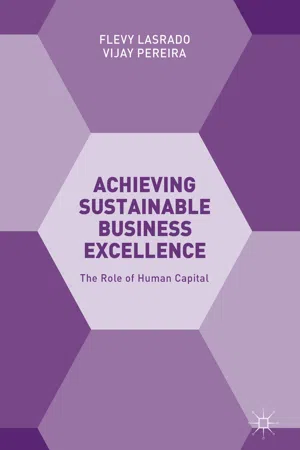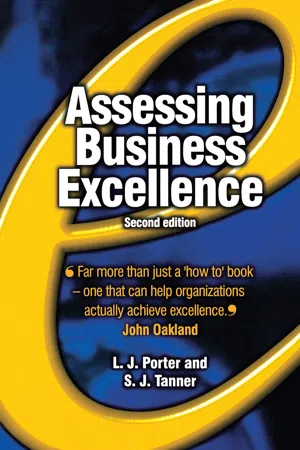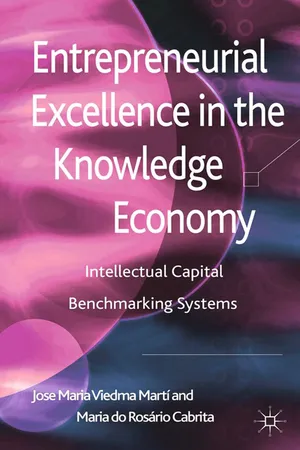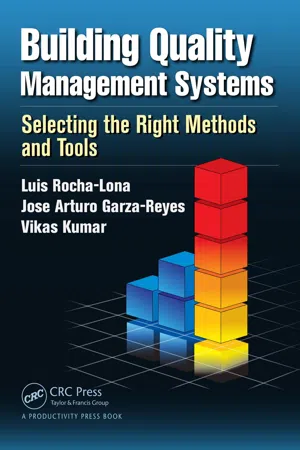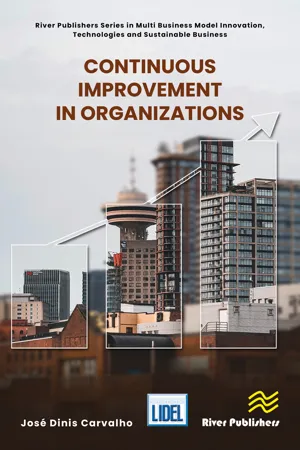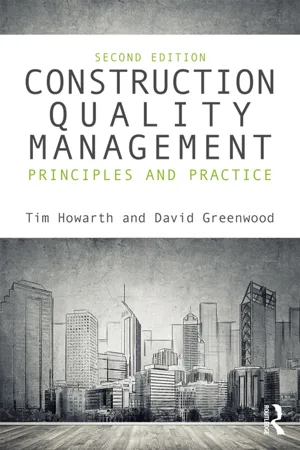Technology & Engineering
Business Excellence Model
The Business Excellence Model is a framework that helps organizations achieve and sustain high levels of performance by focusing on leadership, strategy, people, partnerships, resources, processes, and customer results. It provides a structured approach for organizations to assess and improve their overall performance and drive continuous improvement.
Written by Perlego with AI-assistance
Related key terms
1 of 5
8 Key excerpts on "Business Excellence Model"
- eBook - ePub
- Mateusz Tomanek, Wojciech Cieslinski, Michal Polasik, Mateusz Tomanek, Wojciech Cieslinski, Michal Polasik(Authors)
- 2022(Publication Date)
- Taylor & Francis(Publisher)
Cieśliński, 2018 , 2018a) concerning the digital maturity of an organization, namely:- the need to convert resources from analogue to digital
- the necessity for convergence of the organization’s business processes
- the need for convergence of the organization’s information technology infrastructure (Figure 3.10 ).
- streaming flows of values
- gamification
- machine processing (Figure 3.11 ).
The following list is an overview of the definitions of the main concepts used in the study, their description and explanation: organizational space, business models, models of excellence, and digital models including the digital maturity of the organization. These concepts constitute a cognitive-methodological reference point for describing and explaining the issues analysed in terms of a satisfaction problem in sport. They contribute to the search for an answer to the question of what business model a sports organization should adopt in order to be competitive in the market for sports services in terms of satisfaction from practising a sport, watching a sports spectacle and sponsor satisfaction. The Business Excellence Model (BEM) and the Digital Business Excellence Model (DBEM) are derived from the business model adopted (BM; Figure 3.12 ).Figure 3.12 SBM – Business model as an indicator of sports organisation activities.‘Values’ refers to the sportsperson, fan, and sponsor. Quality is determined by BEMs and DBEMs. It is the business model that determines the direction of a sports organization towards a continuous improvement process and DBEMs, or organizational improvement in the search for the modern ICT technologies that will aid achievement of satisfaction. - eBook - ePub
Achieving Sustainable Business Excellence
The Role of Human Capital
- Flevy Lasrado, Vijay Pereira(Authors)
- 2018(Publication Date)
- Palgrave Macmillan(Publisher)
In this introductory chapter, we define these questions and more. We define BE and analyse its underlying principles, present an overview of global BE models (BEMs) and identify the common themes within them, and provide best practice examples of the ways in which high-performing organisations have implemented various excellence principles.Introduction to Business Excellence
Simply put, excellence means taking steps to ensure that the techniques and strategies that work today will be implemented in an even better and wiser way tomorrow. In an organisational context, excellence manifests itself through leaders and the management, who are dedicated to the continuous improvement of their organisation’s key processes, working conditions, morale, and general organisational culture. While a ‘good’ organisation uses sustainability, innovation, diversity, and risk management to provide product and process quality, a truly excellent organisation goes above and beyond by satisfying its customers, employees, and any other stakeholders while at the same time presenting a clear vision for achieving the same or greater outcomes in the future. Mann et al. (2011 ) described excellent organisations as those that strive to be not only ahead in their profits, but also outstanding in everything they do by implementing ‘improvement programs, initiatives and quality tools’ (p. 10) to develop and strengthen management practices and organisational processes, thereby improving their overall performance and creating value for their stakeholders. More precisely, the idea behind BE is that quality should not be focused only on the products and services produced by the organisation; it should be the fundamental value of the organisation’s management strategy (Evans 2008 ).BE is therefore a philosophy of management or management approach that emphasises the importance of transformation in business processes and of striving for continuous improvement within an organisation to yield superior performance. On the other hand, total quality management (TQM) (also known as total productive maintenance) ‘defines a management approach to long-term success through customer satisfaction. In a TQM effort, all members of an organisation [i.e. its human capital] participate in improving processes, products, services, and the culture in which they work’ (ASQ 2017 ). While the TQM movement that began in the late 1980s has admittedly run its course, TQM organisations that implemented BE early on in their life cycles have long reported consistently high performance and market success, providing valuable examples for companies that wish to achieve similar excellence (Matias and Coelho 2011 ; Zairi and Alsughayir 2011 ). Thus, BE principles developed in and modelled by - eBook - ePub
- Les Porter, Steve Tanner(Authors)
- 2012(Publication Date)
- Routledge(Publisher)
Part One The Case for Business Excellence DOI: 10.4324/9780080493930-1Passage contains an image
1 Introducing Business Excellence
DOI: 10.4324/9780080493930-21.1 Introduction
In the last two decades, organizations have experienced a period of great change in their markets and operations. International competition has meant that many organizations have faced an increasingly turbulent and hostile environment. Customers have become more demanding, competition has become more intense and sophisticated, and the pace of technological change has quickened. Regulators and consumer groups have also added to these pressures. As a result, many organizations have adopted a range of improvement approaches in response to these forces. We have seen the growing adoption of quality management systems standards such as ISO9000, the emergence of total quality management (TQM), business process engineering (BPR), business excellence, performance excellence, lean thinking, Six Sigma etc. The battle weary could be excused from taking a rather jaundiced view of this ever lengthening list of ‘quality’ offers, but, by and large, they fit into an integrated approach to organizational improvement.The involvement of people in the continuous improvement and transformation of business processes is a fundamental theme that runs through all of these quality improvement, process improvement and excellence approaches. By definition, this requires measurement and an understanding of how superior performance can be achieved. Assessing business excellence or organizational excellence is an essential part of a learning and measurement process, which involves people in self-assessment and allows organizations to identify strengths and improvement opportunities as well as enabling the progress of excellence programmes to be monitored in a systematic way. Self-assessment is a comprehensive, systematic and regular review of an organization's activities and results referenced against an appropriate Business Excellence Model. These types of business or organizational assessments are one of the most powerful organizational learning tools available. In this book we describe the main excellence frameworks, and explain how they may be used to drive organizational improvement using the process of self-assessment. - eBook - PDF
Entrepreneurial Excellence in the Knowledge Economy
Intellectual Capital Benchmarking Systems
- José Maria Viedma Marti, Maria do Rosario Cabrita(Authors)
- 2012(Publication Date)
- Palgrave Macmillan(Publisher)
Leadership and Constancy of Purpose Excellence is visionary and inspirational leadership, coupled with constancy of purpose. Management by Process and Facts Excellence is managing the organization through a set of interdependent and interrelated systems, processes and facts to create sustained results. People Development and Involvement Excellence is maximising the contribution of employees through their development and involvement. Continuous Learning, Improvement and Innovation Excellence is generating increased value and improved level of performance through systematic innovation by harnessing the creativity of their stakeholders Partnership Development Excellence is developing and maintaining value- adding partnerships. Corporate Social Responsibility Excellence is exceeding the minimum regulatory framework in which the organization operates and to strive to understand and respond to the expectations of its stakeholders in society. Source: Adapted from the EFQM readings based on http://www.efqm.org/en/ The Practice of Entrepreneurial Excellence 121 The Criteria for Performance Excellence have evolved significantly over time to help organizations address a dynamic environment, focus on strategy-driven performance, and address concerns about customer and workforce engagement, governance and ethics, societal responsi- bilities, and long-term organizational sustainability. The Criteria have continually progressed toward a comprehensive, integrated systems perspective of organizational performance management. The criteria are built on the following set of inter-related core values and concepts: visionary leadership; customer-driven excellence; organizational and personal learning; valuing employees and partners; agility; focus on the future; managing for innovation; management by fact; social respon- sibility; focus on results and creating value; and system perspective. - eBook - PDF
Building Quality Management Systems
Selecting the Right Methods and Tools
- Luis Rocha-Lona, Jose Arturo Garza-Reyes, Vikas Kumar(Authors)
- 2017(Publication Date)
- Productivity Press(Publisher)
15 Chapter 2 Business Excellence Models 2.1 Introduction—QMSs and Business Models A business model describes the way an organization develops, transforms, and delivers its products and services to the market. In other words, it describes the rationale and relationships required by an organization to operate in its industry. Understanding this is fundamental to determining the role of quality management systems (QMSs) and how they relate to the busi-ness model under a systems approach. Several elements should be consid-ered in developing business models, namely, the customer segments, value propositions, distribution channels, customer relationships, revenue streams, key resources, key activities, partnerships, and cost of structure (Ostenwalder and Pigneur, 2010). In addition to these elements, a business should con-duct an industry analysis through benchmarking, and ensure that it has the required resources and capabilities to operate. Understanding these elements may seem trivial, but very few individuals and companies deploy and cor-rectly integrate the right business elements and tools to succeed. Figure 2.1 shows the rationale for QMSs, the business model, and the overall business strategy. The core elements for operating as a system that delivers value to internal and external customers are based on human capi-tal, key processes, information technology (IT), and knowledge management (KM). To be successfully integrated into a full business model, all of these elements require a structure, documentation, and effective management. Customers are the reason for any organization; without them, there is no reason to exist. Product development and innovation should be integrated to capture the voice of the customer (VOC) and produce high-value-added 16 ◾ Building Quality Management Systems products that meet customers’ expectations and lead to loyalty. - eBook - ePub
Connected, Intelligent, Automated
The Definitive Guide to Digital Transformation and Quality 4.0
- Nicole Radziwill(Author)
- 2020(Publication Date)
- ASQ Quality Press(Publisher)
Take a public safety-first responder project I was involved in years ago. We stakeholders weren’t speaking the same language. The municipality referred to “edge” as the data visible to dispatchers at its network operations center. The drone company defined “edge” as the computing and AI capability running in real time on the drone. We considered “edge” the transport and compression capabilities to determine response time in the cellular network and on the drone. Technically speaking, all these are edge components. (Allgood, 2019)Lack of a common vernacular, a basis for understanding one another, or mutual trust can threaten any project or initiative. Roles and responsibilities should be clearly articulated at the individual and team levels. Inputs, outputs, and decision-making processes should be clarified and written down so that no one has to guess or make assumptions. Project details, initiatives, agreements, and updates should be captured and formalized to eliminate subjectivity as much as possible. The greatest enemy of communication is the illusion of it.WHAT IS PERFORMANCE EXCELLENCE?A model is a map for understanding a complex system (Edgeman, 2019); frameworks for performance excellence are models that help build understanding and trust in organizations. As defined by the Baldrige Excellence Framework and explained in detail by Thü rer et al. (2018), performance excellence isan integrated approach to organizational performance management that results in 1.delivery of ever-improving value to customers and stakeholders, contributing to ongoing organizational success; 2.improvement of your organization’s overall effectiveness and capabilities; and 3.learning for the organization and for people in the workforce.These frameworks go by several names, including business excellence, operational excellence, and organizational excellence. They provide guidance for describing work, aligning objectives with strategy, and monitoring progress so that organizations can more easily adjust dynamically. These frameworks share common features, including a focus on the customer, core values that include efficiency and effectiveness, and an emphasis on risk-based thinking and data-driven decision making. They provide a basis for establishing a quality culture, navigating the dynamics of control and power, and providing the discipline that leads to order and innovation (Freeman, 2019). Most significantly, using an excellence framework increases opportunities for genuine communication across functional and organizational boundaries, and focuses everyone in the organization on continuous improvement. - eBook - ePub
- José Dinis Carvalho(Author)
- 2023(Publication Date)
- River Publishers(Publisher)
Excellence” here is just a term of everyday language that in general all people understand. We are familiar to the word “excellent” as an adjective to refer to a dish served to us or to anything else. We can say that a certain person is an “excellent” speaker or an “excellent” professional. It is with this kind of interpretation that we want the term excellent to be understood here in this book. Next, we will clarify the meaning of Excellence in organizations that is assumed in this book.There are three frequently published concepts that use the term excellence and are relevant in this context. These concepts are Business Excellence, Operations Excellence and Service Excellence. The relative position between Business Excellence and Operational Excellence is presented in an interesting article by Cindy Johnson of Texas Instruments (Johnson, 1997 ), in which Business Excellence is the highest level goal and Operational Excellence one of the supporting instruments. Regarding the roles of Operational Excellence and Service Excellence, Thürer, Tomašević, Stevenson, Fredendall, & Protzman (2018) suggest in their article that the former is related to efficiency and the latter to effectiveness. It actually makes some sense since “effectiveness” is getting the goal accomplished while “efficiency” is getting the goal accomplished but using less resources/effort/time.There are several possible definitions for Operational Excellence but we will only mention here some that are aligned with our way of thinking, and they are the following:- “Providing customers with reliable products or services at competitive prices and delivered with minimal difficulty and inconvenience” (Kamann, 2007 );
- “The degree to which a firm is better than its competitors in responsiveness and generating productivity improvements” (Rai, Patnayakuni, & Seth, 2006 );
- “Outstanding achievements in manufacturing or service processes and productivity improvements, quality improvements and customer service” (Chakravorty, Atwater, & Herbert, 2008 );
- “Operational excellence in simple words is when improvements are made to gain a competitive advantage” (Sony, 2019 ).
These and other definitions almost always focus on the issue of improved performance in the production of goods or services. We could then assume that an organization has a higher degree of Excellence than its competitors if it has better global performance. This global performance includes performance such as productivity, product quality, speed in satisfying orders, service quality, low costs, motivated and satisfied employees, good relationships with suppliers, etc. - eBook - ePub
Construction Quality Management
Principles and Practice
- Tim Howarth, David Greenwood(Authors)
- 2017(Publication Date)
- Routledge(Publisher)
The EFQM Excellence Model was formerly known as the Business Excellence Model. It was developed between 1989 and 1991 by practitioners to bring together the various models for Total Quality Management (TQM) deployment.European organisations were experiencing difficulties in the implementation of TQM principles and hence attaining the following benefits of TQM application in practice:- the production of a higher quality product/service through the systematic consideration of clients’ requirements;
- a reduction in the overall process/time and costs via the minimisation of potential causes of errors and corrective actions;
- increased efficiency and effectiveness of all personnel with activities focused on customer satisfaction; and
- improvement in information flow between all participants through team building and proactive management strategies.
- Simple [easy to understand and use]; holistic [in covering all aspects of an organisation’s activities and results, yet not being unduly prescriptive]; dynamic [in providing a live management tool which supports improvement and looks to the future]; flexible [being readily applicable to different types of organisations and to units within those organisations]; innovative.
(European Foundation for Quality Management 1999b)The EFQM Excellence Model has been used extensively and beneficially in manufacturing, construction, banking and finance, education, management and consultancy. Companies apply the EFQM Excellence Model, as the pursuit of business excellence through TQM is a decisive factor in enabling competitiveness in today’s global market place.EFQM is a non-profit making organisation providing various networking, benchmarking and training events to help members keep up with the latest trends in business management and research in TQM. It launched the European Quality Award in 1991 to stimulate interest and it is awarded to those who have given ‘exceptional attention’ to TQM.The British Quality Foundation is the UK sponsor of the EFQM Excellence Model. The aim of the British Quality Foundation is to promote continuous improvement and organisational excellence using the EFQM Excellence Model. The philosophy of the Foundation is succinctly expressed in the following quote:
Index pages curate the most relevant extracts from our library of academic textbooks. They’ve been created using an in-house natural language model (NLM), each adding context and meaning to key research topics.

